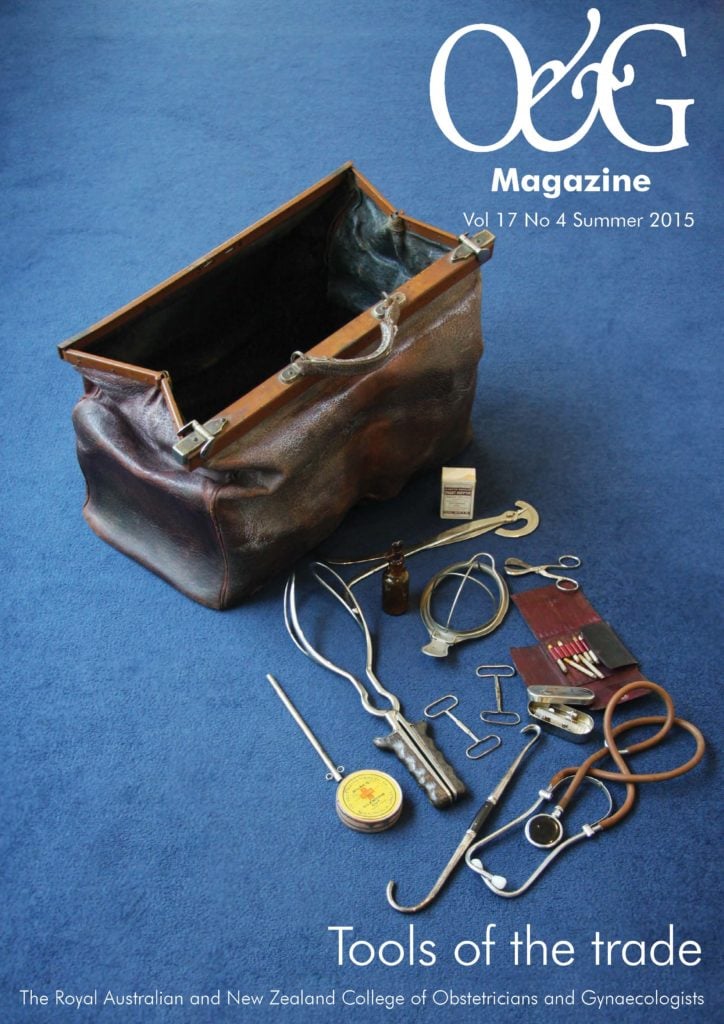Abnormal uterine bleeding (AUB) is defined as any bleeding from the uterus that is abnormal in frequency, volume, duration or regularity.1 It is estimated that AUB affects between ten and 30 per cent of women and has significant social and economic impact.2 AUB may be secondary to structural issues (polyps or myomas), non-structural causes (ovulatory dysfunction, endocrine disorders) or related to a cause not yet determined. After appropriate history and clinical evaluation, medical and surgical treatment strategies may be considered. While hysterectomy remains the definitive treatment option for AUB, women may prefer endometrial ablation as a less-invasive treatment and/or to reduce the surgical risk associated with a major procedure.
Endometrial ablation is an option for the treatment of AUB in women who have completed their families, where medical treatment is either contraindicated or unsatisfactory or who choose this as an option, and has been shown to restore quality of life to the standard of the general population.3 Compared to a composite of modes of hysterectomy (abdominal, laparoscopic and vaginal), endometrial ablation has been shown to be less costly in both the short term and at five years when direct and indirect costs are considered.4
A variety of endometrial ablation techniques and devices have been evaluated and used. The procedures initially developed are usually referred to as first-generation devices. More commonly used in Australasia (and throughout the world) are second-generation devices that include thermal balloon ablation (Thermablate™, Thermachoice®, Cavaterm™) and bipolar ablation (NovaSure®). These are the only devices currently used in Australia and New Zealand.
First-generation endometrial ablation
First-generation ablation devices include rollerball endometrial ablation and transcervical endometrial resection, often used in combination. Transcervical endometrial resection uses the hysteroscopic loop resectoscope to resect endometrium to the superficial myometrium, removing all basalis (see the O&G app for a demonstration video). Rollerball endometrial ablation applies an electrosurgical current through a specific electrode that is inserted through the working channel of an operative hysteroscope and does not remove the endometrium, rather destroys the basalis under direct hysteroscopic vision. Both of these techniques require a non-conductive fluid, such as glycine, to allow consistent current transmission to the tissue.
For these techniques, pre-treatment with GnRH agonists, danazol or progestogens has been used to thin the endometrium in an attempt to make the operation easier to perform. Although pre-treatment reduces the length of the procedure, it does not improve rates of amenorrhoea or hypomenorrhoea5, nor does it reduce the incidence of operative complications.6 The routine use of endometrial thinning agents prior to endometrial ablation therefore adds cost and potential side effects for the woman without significantly altering the outcome of her procedure and cannot be recommended.
Outcomes from rollerball ablation from a retrospective study of 190 patients include a 30 per cent rate of amenorrhoea at five years follow up and a further 40 per cent of women with hypomenorrhoea.7 Reported complications from electrosurgical ablation techniques include a 4.44 per cent total complication rate, with a 2.38 per cent rate of haemorrhage and a 1.48 per cent rate of perforation.6 Surgical inexperience is a recognised risk factor for complications with first-generation procedures8 and these are now less commonly performed, with Australian procedure numbers from 2014 one-third the number of 20 years ago.9
Table 1. A summary of ablation technologies.
| Diameter | Distension medium | Time (min) | Temperature | Pressure | Outcomes | |
|---|---|---|---|---|---|---|
| Rollerball | 10mm | Glycine | Mean 30 | N/A | N/A | Equal efficacy between first- and second-generation techniques for amenorrhoea and no difference in re-intervention rates (rate ratio 0.74, CI 0.33-1.66, p+0.47)10 Lower risk of complications in secondgeneration procedures (RR 0.2)11 12 Bipolar versus balloon ablation – shorter operation, improved amenorrhoea rates13 |
| Endometrial | ||||||
| resection | 10mm | Glycine | Mean 30 | N/A | N/A | |
| Cavaterm | 6–7mm | Glucose 5% | 10 | 78°C | 230–240mmHg | |
| Thermablate | 6mm | glycerine | 2 | 173°C | 180mmHg | |
| Thermachoice | 5mm | 5% dextrose in water | 8 | 87°C | 160–180mmHg | |
| NovaSure | 7.5mm | N/A | Maximum 2 | N/A | N/A |
Second-generation endometrial ablation
Second-generation devices were developed to overcome some of the limitations of first-generation ablation – including the learning curve and surgeon variability. The options available in Australia and New Zealand include thermal balloon devices and bipolar radiofrequency ablation. Other options that are available overseas include cryotherapy and free fluid thermal ablation.
Hysteroscopy should always be performed before any second-generation ablation, to ensure the correct diagnosis of the AUB, excluding malignant and pre-malignant conditions. Additionally, hysteroscopy will identify any focal pathology, such as submucosal myomas or polyps, that may not only cause AUB, but are also a recognised risk factor for failure of ablation (hazard ratio 5.22, CI 1.63-16.73).14 15
Contraindications to second-generation ablation include active pelvic infection and any non-lower segment uterine scar; as such scars have the potential to have thinned the myometrium and pose a potential risk of thermal injury to visceral structures. Lower segment caesarean delivery does not pose a risk during ablation procedures, as the scar is at the level of the cervix. If symptoms of AUB persist after a second-generation ablation procedure, repeat ablation with a second-generation device is contraindicated as the initial ablation will have changed the myometrial impedance, increasing the risk of thermal injury to surrounding structures.
Pre-treatment counselling should include consideration of contraceptive needs, as ablation is not a contraceptive procedure. Pregnancy after ablation has high morbidity, with case reports of uterine rupture16 and disordered placentation such as placenta accreta.17 Concomitant contraceptive procedures that may be performed at the time of ablation include laparoscopic tubal sterilisation, hysteroscopic sterilisation or insertion of an intrauterine device.
Techniques
The balloon devices (Thermachoice®, Cavaterm™, Thermablate™) all have similar mechanisms of action and rely on a silicone or latex balloon that is placed within the endometrial cavity connected to an automated unit that circulates pre-heated fluid through the balloon for a specified period of time.
The NovaSure® device uses bipolar, radiofrequency impedance technology to ablate the endometrium.18 The ablation device is an electrode array housed within a protective sheath that is deployed within the uterine cavity. The cavity integrity assessment (CIA), using carbon dioxide, must be passed before the procedure can be commenced. This is an added safety feature, as the CIA will fail and the device will not be able to be activated if there is any breach to the cavity, such as occurs in the instance of uterine perforation. Steam, blood and any tissue are removed from the cavity through continuous suction during the procedure.
Limitations to the use of the second-generation devices include abnormalities of the uterine contour such as most Mullerian tract anomalies or type 0 or 1 leiomyomas that prevent the ablation device from contacting the endometrium. Extremes of uterine length or width are contraindications for use for several of the devices (uterine length greater than 10cm (Thermachoice), 12cm (Cavaterm), or less than 4cm in length or 2cm in width (NovaSure).
Evidence
A systematic review has found first- and second-generation endometrial ablation procedures to be equally effective in improving heavy menstrual bleeding (RR 0.98, CI 0.92-1.04, P=0.50)19 with similar patient satisfaction rates. Compared to first-generation ablation, the benefits of second generation devices include a shorter operative time by 16 minutes (p<0.001), and a higher likelihood the procedure can be performed under local anaesthetic.20
Balloon and bipolar ablation have fewer minor Clavien Dindo grade 1 complications compared to first-generation procedures (0 per cent versus 3.2 per cent balloon, 0.6 per cent versus 6.7 per cent bipolar)15-17 (RR 0.29, CI 0.14-0.57, P<0.001). However, there is no evidence of a difference in the rate of more serious complications, with these complications reported for all types of endometrial ablation technologies.21
When bipolar and thermal balloon ablation are compared, bipolar ablation is faster22 and has higher initial rates of amenorrhoea (odds ratio 4.56, CI 2.24-9.26, p<0.001).23 24 25 26 However, at ten-year follow up, patient satisfaction rates and numbers of patients requiring further treatment are similar, regardless of whether balloon or bipolar ablation is used.27 This is likely owing to a high percentage of women becoming menopausal within this timeframe.
Table 2. A summary of the outcomes, re-intervention rates and complications for endometrial ablation devices.
| Outcomes | Reintervention | Complications | |
|---|---|---|---|
| First generation | 30% rate of amenorrhoea at five years’ follow up and a further 40% of women with hypomenorrhoea28 | Hysterectomy rates 7–30 % at 1–5 years29 | Complication rate up to 4.44%, including haemorrhage and uterine perforation30 |
| Balloon ablation | Initial amenorrhoea rates of 18%31 to 56%32 30% rate of hypomenorrhoea33 | Hysterectomy rate 9% at five years and 21% at 7–10 years34 | Reduced intraoperative complications in balloon group compared to rollerball (3.2 % versus 0 %)35 |
| Bipolar ablation | Amenorrhoea rates 46–58% at 6–12 months36 Higher rate of amenorrhoea compared to other second-generation devices (rate ratio 2.6, CI 1.63-4.14, p<0.001)37 | Similar rates of reintervention (RR 0.9, CI -.63- 1.3) and patient satisfaction (RR 1.1, CI 0.82- 1.2) between bipolar and balloon ablation after ten years38 Hysterectomy or retreatment rates <5% at five years39 | Lower intraoperative complication rate than first generation procedures (0.6% versus 6.7%)40 |
Other techniques
Procedures not performed in Australia include hydrothermablation (HTA) and cryoablation (Her Option®). HTA is a type of ‘free fluid’ ablation and is used in the USA. In this procedure, room-temperature saline is instilled inside the uterus and then heated to 90°C, with a treatment time of ten minutes. The procedure is performed under hysteroscopic monitoring. At the end of the procedure, cooled saline is circulated
within the uterus. Cryoablation involves inserting a probe into the uterine cavity, which is then cooled to -90°C using liquid nitrogen, resulting in a frozen zone involving the endometrium and myometrium. Two or three cycles of treatment may be required.
Procedures no longer performed
Techniques previously used to ablate the endometrium that have now been removed from the market include microwave endometrial ablation (MEA), Vesta balloon (radiofrequency ablation via electrodes on the surface of a balloon) and endometrial laser intrauterine thermal therapy (ELITT). These products were removed owing to production costs and the competitive market in this area of clinical medicine.
Conclusion
Endometrial ablation is a management option for women with abnormal uterine bleeding. The current evidence favours second-generation devices that have high rates of amenorrhoea and fewer minor complications when compared to first-generation devices. It is important for clinicians to have an understanding of the technology available, appropriate patient selection and potential risks associated with use of the devices.
Further information
www.ethicon.com/healthcare-professionals/products/uterine-pelvic/endometrial-ablation/gynecare-thermachoice
www.youtube.com/watch?v=Cz8nWN2ou4g
www.climate.edu.au/OandGapp/Vol17No4/Videos/Endometrial_Resection.mp4
www.climate.edu.au/OandGapp/Vol17No4/Videos/Jason_Abbott.mp4
www.climate.edu.au/OandGapp/Vol17No4/Videos/Novasure_Ablation.mp4
www.icvclients.com/novasure/device_seating_animation/
Disclosure
Jason Abbott is a paid consultant for Hologic and is on their speakers’ bureau. He has no shares or equity within the company.
References
- Management of Acute Abnormal Uterine Bleeding in Nonpregnant Reproductive-Aged Women Committee Opinion No.557. American Congress of Obstetricians and Gynecologists. Obstetrics and Gynecology. 2013;121:891-6.
- Liu Z, Doan QV, Blumenthal P, Dubois RW. A systematic review evaluating health-related quality of life, work impairment, and health-care costs and utilization in abnormal uterine bleeding. Value Health. 2007;10(3):183-94.
- Abbott JA, Hawe J, Garry R. Quality of life should be considered the primary outcome for measuring success of endometrial ablation. J Am Assoc Gynecol Laparosc. 2003;10(4):491-5; discussion 5.
- Miller JD, Lenhart GM, Bonafede MM, Lukes AS, Laughlin-Tommaso SK. Cost-Effectiveness of Global Endometrial Ablation vs. Hysterectomy for Treatment of Abnormal Uterine Bleeding: US Commercial and Medicaid Payer Perspectives. Popul Health Manag. 2015.
- Tan YH, Lethaby A. Pre-operative endometrial thinning agents before endometrial destruction for heavy menstrual bleeding. Cochrane Database Syst Rev. 2013;11:Cd010241.
- Overton C, Hargreaves J, Maresh M. A national survey of the complications of endometrial destruction for menstrual disorders: the MISTLETOE study. Minimally Invasive Surgical Techniques–Laser, EndoThermal or Endorescetion. BJOG. 1997;104(12):1351-9.
- Preutthipan S, Herabutya Y. Hysteroscopic rollerball endometrial ablation as an alternative treatment for adenomyosis with menorrhagia and/or dysmenorrhea. J Obstet Gynaecol Res. 2010;36(5):1031-6.
- Overton C, Hargreaves J, Maresh M. A national survey of the complications of endometrial destruction for menstrual disorders: the MISTLETOE study. Minimally Invasive Surgical Techniques–Laser, EndoThermal or Endorescetion. BJOG. 1997;104(12):1351-9.
- Medicare Item Reports [Internet]. Australia: Medicare etc . Available from http://medicarestatistics.humanservices.gov.au/statistics/mbs_item.jsp .
- Kroft J, Liu G. First- versus secondgeneration endometrial ablation devices for treatment of menorrhagia: a systematic review, meta-analysis and appraisal of economic evaluations. J Obs
- Meyer WR, Walsh BW, Grainger DA, Peacock LM, Loffer FD, Steege JF. Thermal balloon and rollerball ablation to treat menorrhagia: a multicenter comparison. Obstet Gynecol. 1998;92(1):98-103.
- Cooper J, Gimpelson R, Laberge P, Galen D, Garza-Leal JG, Scott J, et al. A randomized, multicenter trial of safety and efficacy of the NovaSure system in the treatment of menorrhagia. J Am Assoc Gynecol Laparosc. 2002;9(4):418-28.
- Kroft J, Liu G. First- versus secondgeneration endometrial ablation devices for treatment of menorrhagia: a systematic review, meta-analysis and appraisal of economic evaluations. J Obs
- Gemer O, Kruchkovich J, Huerta M, Kapustian V, Kroll D, Anteby E. Perioperative predictors of successful hysteroscopic endometrial ablation. Gynecol Obstet Invest. 2007;63(4):205-8.
- Wishall KM, Price J, Pereira N, Butts SM, Della Badia CR. Postablation risk factors for pain and subsequent hysterectomy. Obstet Gynecol. 2014;124(5):904.
- Bowling MR, Ramsey PS. Spontaneous uterine rupture in pregnancy after endometrial ablation. Obstet Gynecol. 2010;115(2 Pt 2):405-6.
- Gill LA, Baldwin E, Lessard-Anderson C, White W. Septic abortion with placenta accreta in pregnancy after endometrial ablation. Obstet Gynecol. 2015;125(4):822-4.
- Gimpelson RJ. Ten-year literature review of global endometrial ablation with the NovaSure(R) device. Int J Womens Health. 2014;6:269-80.
- Kroft J, Liu G. First- versus secondgeneration endometrial ablation devices for treatment of menorrhagia: a systematic review, meta-analysis and appraisal of economic evaluations. J Obstet Gynaecol Can. 2013;35(11):1010-9.
- Kroft J, Liu G. First- versus second-generation endometrial ablation devices for treatment of menorrhagia: a systematic review, meta-analysis and appraisal of economic evaluations. J Obstet Gynaecol Can. 2013;35(11):1010-9.
- Kroft J, Liu G. First- versus second-generation endometrial ablation devices for treatment of menorrhagia: a systematic review, meta-analysis and appraisal of economic evaluations. J Obstet Gynaecol Can. 2013;35(11):1010-9.
- Lethaby A, Penninx J, Hickey M, Garry R, Marjoribanks J. Endometrial resection and ablation techniques for heavy menstrual bleeding. Cochrane Database Syst Rev. 2013;8:Cd001501.
- Bongers MY, Bourdrez P, Mol BW, Heintz AP, Brolmann HA. Randomised controlled trial of bipolar radiofrequency endometrial ablation and balloon endometrial ablation. BJOG. 2004;111(10):1095-102.
- Abbott J, Hawe J, Hunter D, Garry R. A double-blind randomized trial comparing the Cavaterm and the NovaSure endometrial ablation systems for the treatment of dysfunctional uterine bleeding. Fertil Steril. 2003;80(1):203-8.
- Penninx JP, Mol BW, Engels R, van Rumste MM, Kleijn C, Koks CA, et al. Bipolar radiofrequency endometrial ablation compared with hydrothermablation for dysfunctional uterine bleeding: a randomized controlled trial. Obstet Gynecol. 2010;116(4):819-26.
- Daniels JP, Middleton LJ, Champaneria R, Khan KS, Cooper K, Mol BW, et al. Second generation endometrial ablation techniques for heavy menstrual bleeding: network meta-analysis. BMJ. 2012;344:e2564.
- Herman MC, Penninx JP, Mol BW, Bongers MY. Ten-year follow-up of a randomised controlled trial comparing bipolar endometrial ablation with balloon ablation for heavy menstrual bleeding. BJOG. 2013;120(8):966-70.
- Preutthipan S, Herabutya Y. Hysteroscopic rollerball endometrial ablation as an alternative treatment for adenomyosis with menorrhagia and/or dysmenorrhea. J Obstet Gynaecol Res. 2010;36(5):1031-6.
- Dutton C, Ackerson L, Phelps-Sandall B. Outcomes after rollerball endometrial ablation for menorrhagia. Obstet Gynecol. 2001;98(1):35-9.
- Overton C, Hargreaves J, Maresh M. A national survey of the complications of endometrial destruction for menstrual disorders: the MISTLETOE study. Minimally Invasive Surgical Techniques–Laser, EndoThermal or Endorescetion. BJOG. 1997;104(12):1351-9.
- Gervaise A, Fernandez H, Capella-Allouc S, Taylor S, La Vieille S, Hamou J, et al. Thermal balloon ablation versus endometrial resection for the treatment of abnormal uterine bleeding. Hum Reprod 1999;14(11):2743-7.
- Bouzari Z, Yazdani S, Azimi S, Delavar MA. Thermal balloon endometrial ablation in the treatment of heavy menstrual bleeding. Med Arch. 2014;68(6):411-3.
- Bouzari Z, Yazdani S, Azimi S, Delavar MA. Thermal balloon endometrial ablation in the treatment of heavy menstrual bleeding. Med Arch. 2014;68(6):411-3.
- Penezic L, Riley K, Harkins G. Long-term patient satisfaction with thermal balloon ablation for abnormal uterine bleeding. JSLS. 2014;18(3).
- Meyer WR, Walsh BW, Grainger DA, Peacock LM, Loffer FD, Steege JF. Thermal balloon and rollerball ablation to treat menorrhagia: a multicenter comparison. Obstet Gynecol. 1998;92(1):98-103.
- Gallinat A, Nugent W. NovaSure impedance-controlled system for endometrial ablation. J Am Assoc Gynecol Laparosc. 2002;9(3):283-9.
- Kroft J, Liu G. First- versus secondgeneration endometrial ablation devices for treatment of menorrhagia: a systematic review, meta-analysis and appraisal of economic evaluations. J Obstet Gynaecol
- Herman MC, Penninx JP, Mol BW, Bongers MY. Ten-year follow-up of a randomised controlled trial comparing bipolar endometrial ablation with balloon ablation for heavy menstrual bleeding. BJOG. 2013;120(8):966-70.
- Gallinat A. An impedance-controlled system for endometrial ablation: five-year follow-up of 107 patients. J Reprod Med. 2007;52(6):467-72.
- Kroft J, Liu G. First- versus secondgeneration endometrial ablation devices for treatment of menorrhagia: a systematic review, meta-analysis and appraisal of economic evaluations. J Obstet Gynaecol Can. 2013;35(11):1010-9.







Leave a Reply